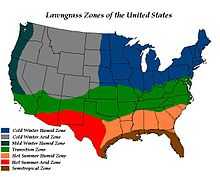Lawns in the United States

In a 2005 NASA-sponsored study, it was estimated that the area covered by lawns in the United States to be about 128,000 square kilometres (49,000 sq mi), making it the nation's largest irrigated crop by area.[1] Lawn care is thus a major business in the United States; maintenance, construction and management of lawns of various kinds being the focus of much of the modern horticulture industry. Estimates of the amount spent on professional lawn care services vary, but a Harris Survey put the total at $28.9 billion in 2002 (approximately $1,200 per household using such services).
In her book The Lawn: A History of an American Obsession (1994) Virginia Scott Jenkins traces the historic desire to kill weeds. She notes that the current rage for a chemically dependent lawn emerged after World War II and argues that "American front lawns are a symbol of man's control of, or superiority over, his environment."
According to the EPA, "of the 26 billion gallons of water consumed daily in the United States, approximately 7.8 billion gallons, or 30 percent, is devoted to outdoor uses. The majority of this is used for irrigation."[2]
Along with trees, lawns are a vital element in the fight against urban heat islanding. Lawns provide:
- Oxygen conversion,
- Filtering of air particulates,
- Erosion control,
- Air and surface cooling to offset asphalt, cement, and rooftops,
- A place for recreation and enjoyment.
In comparison to bare dirt, a lawn may be 20 °F cooler on a hot day, and up to 40 °F cooler than cement surfaces.
Lawnmowers
Some companies and brands of lawn mowers in the US include:
- The Grasshopper Company
- Sensation Lawn Mowers, a commercial lawnmower brand
US lawn mower patents
- US patent Lawn mowers
- U.S. Patent 7,117,660, Filed April 12, 2000, Issued October 10, 2006. Self-propelled lawn mower [ed., self-propelled lawn mower comprising a microprocessor and at least one cutter]
- U.S. Patent 4,964,265, Filed September 11, 1989, Issued October 23, 1990. [ed., remote control lawn mower]
- U.S. Patent 1,050,799, Filied March 28, 1910, Issued January 21, 1913 [ed., Stephen Foster Briggs gas engine igniter]
- U.S. Patent 624,749, Lawn mower. Filed September 8, 1898, Issued May 9, 1899.[3] (ed., John Albert Burr, African-American inventor)
- U.S. Patent 210,654, Filed September 30, 1878, Issued December 10, 1878. [ed., leaf catcher]
- U.S. Patent 190,994, Issued May 22, 1877. [ed., leaf catcher]
- U.S. Patent 158,794, Filed November 28, 1874, Issued January 19, 1875.
- U.S. Patent 73,807 [ed., roller mower]
- U.S. Patent 69,409 [ed. Titled "lawn mower".]
- US patent Mowing machines
- U.S. Patent 38,381
- U.S. Patent 33,578
- U.S. Patent 32,244
- U.S. Patent 31,668, Issued March 12, 1861.
- Designs
- U.S. Patent D346,809, Filed April 24, 1992, Issued May 10, 1994. [ed., remote control lawn mower design]
- Reissued US patent
- U.S. Patent RE3,330, Issued March 16, 1869.
See also
- History of the lawn
- Lawn, a town in Taylor County, Texas
References
- ↑ "Looking for Lawns" - general interest article about the NASA study
- ↑ "Conserving Water" - EPA tips to conserve water
- ↑ Ben Ikenson (2004). Patents: Ingenious Inventions, How They Work and How They Came to Be. Black Dog & Leventhal Publishers. 288 pages. Page 213
Further reading
- Virginia Scott Jenkins (1994) The Lawn: A History of an American Obsession
External links
- A motor lawn mower - Scientific American 13 November, 1897